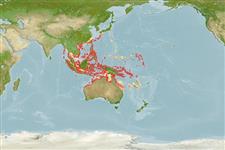>
Eupercaria/misc (Various families in series Eupercaria) >
Nemipteridae (Threadfin breams, Whiptail breams)
Etymology: Pentapodus: Greek, pente = five + Greek, pous = feet (Ref. 45335).
More on author: Cuvier.
Environment: milieu / climate zone / depth range / distribution range
Écologie
marin récifal; profondeur 2 - 35 m (Ref. 90102). Tropical; 33°N - 24°S, 93°E - 175°E (Ref. 3810)
Western Pacific: southern South China Sea and the eastern Malay Peninsula to the Gilbert Islands, north to the Ryukyu Islands, south to Timor and New Caledonia (Ref. 37816). The name Pentapodus caninus has been misapplied to Pentapodus trivittatus.
Taille / Poids / Âge
Maturity: Lm ? range ? - ? cm
Max length : 35.0 cm TL mâle / non sexé; (Ref. 9710); common length : 15.0 cm SL mâle / non sexé; (Ref. 3810)
Épines dorsales (Total): 10; Rayons mous dorsaux (Total): 9; Épines anales 3; Rayons mous anaux: 7. Head scales reaching forward to or just in front of level of anterior nostrils. Scaled area between nostrils with a distinct naked medial wedge-shaped notch. Suborbital scaly posteriorly. Lower limb of preopercle with 2 or 3 scale rows. Pelvic fins moderately long, reaching to or almost to level of anus. Upper lobe of caudal fin slightly longer than lower. Axillary scale present. Color: Upper body pale blue, lower whitish.
Usually found close to the bottom over coral reef areas. Feeds on small fishes and larger zooplankton, as well as on benthic organisms (Ref. 9785). Occurs solitary or in small groups.
Life cycle and mating behavior
Maturité | Reproduction | Frai | Œufs | Fécondité | Larves
Russell, B.C., 1990. FAO Species Catalogue. Vol. 12. Nemipterid fishes of the world. (Threadfin breams, whiptail breams, monocle breams, dwarf monocle breams, and coral breams). Family Nemipteridae. An annotated and illustrated catalogue of nemipterid species known to date. FAO Fish. Synop. 125(12):149p. Rome: FAO. (Ref. 3810)
Statut dans la liste rouge de l'IUCN (Ref. 130435)
Menace pour l'homme
Harmless
Utilisations par l'homme
Pêcheries: pêcheries vivrières
Plus d'informations
Noms communsSynonymesMétabolismePrédateursÉcotoxicologieReproductionMaturitéFraiRassemblement de ponteFéconditéŒufsDéveloppement de l'œuf
RéférencesAquacultureProfil d'aquacultureSouchesGénétiqueElectrophoresesHéritabilitéPathologiesTraitementNutrientsMass conversion
Outils
Articles particuliers
Télécharger en XML
Sources Internet
Estimates based on models
Preferred temperature (Ref.
123201): 26.4 - 29.3, mean 28.7 °C (based on 1974 cells).
Phylogenetic diversity index (Ref.
82804): PD
50 = 0.5002 [Uniqueness, from 0.5 = low to 2.0 = high].
Bayesian length-weight: a=0.01820 (0.01098 - 0.03017), b=2.94 (2.80 - 3.08), in cm total length, based on LWR estimates for this species & (Sub)family-body (Ref.
93245).
Niveau trophique (Ref.
69278): 3.6 ±0.49 se; based on food items.
Résilience (Ref.
120179): Milieu, temps minimum de doublement de population : 1,4 à 4,4 années (Preliminary K or Fecundity.).
Fishing Vulnerability (Ref.
59153): Low vulnerability (25 of 100).
Nutrients (Ref.
124155): Calcium = 51 [32, 107] mg/100g; Iron = 0.707 [0.350, 1.491] mg/100g; Protein = 18.9 [17.0, 20.6] %; Omega3 = 0.138 [0.081, 0.239] g/100g; Selenium = 28.3 [16.3, 52.6] μg/100g; VitaminA = 109 [30, 319] μg/100g; Zinc = 1.12 [0.76, 1.60] mg/100g (wet weight);
